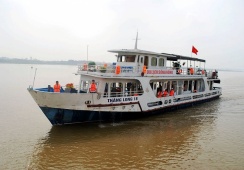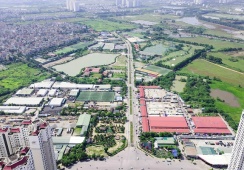
One of Hanoi's key targets in the second half of 2024 is the enforcement of the amended Capital Law and the approval of the two master plans on Hanoi's development, said Ha Minh Hai, Vice Chairman of the Hanoi People's Committee.
| Deputy Chairman of the Hanoi People's Committee Ha Minh Hai presents a report at the government's online conference on July 6. Photo: VGP |
Speaking at the government's online conference on July 6, Hai said the capital would need to draft 97 sub-laws to put the Amended Capital Law into practice, six of which would be drafted by the government.
He suggested that the government and ministries assist Hanoi in this work.
"Hanoi is finalizing the two general development plans after receiving feedback from the Politburo and the National Assembly. We expect to submit them to the Prime Minister for review and approval by July 15."
The amended Capital Law was approved by the National Assembly on June 28.
On other socio-economic issues, Hai said Hanoi will accelerate the progress of key infrastructure projects such as the construction of Ring Road 4, Hai added.
The Hanoi official stressed that the capital hopes to launch the Nhon-Hanoi Station metro line this year and develop a master plan to complete the construction of all 14 metro lines by 2035.
Other important tasks for the capital include celebrating major anniversaries such as the 70th anniversary of Liberation Day (October 10) and the 80th anniversary of the founding of the Vietnam People's Army (December 22).
In addition, the city expects to finalize socio-economic plans for 2025 and 2026-2030, which will prioritize green growth, digital transformation, and circular economy, Hai said.
"The capital will follow the guidance of the Central Party Committee, the Politburo, the National Assembly, the Government and the Prime Minister in drafting these plans," Hai said.
"Hanoi will continue to decentralize authority to subordinate administrations to make them more proactive, creative and dynamic," he added.
Hanoi’s socio-economic performances in H1
Hanoi made good progress in all socio-economic indicators in the first half of the year.
According to the Hanoi People's Committee, Hanoi's GRDP increased by 6% year-on-year in January-June, slightly higher than last year's 5.97%.
Total tax and fee collection increased by 16% year-on-year to VND259 trillion (over US$10 billion), representing 63% of the full-year target. This figure included VND244 trillion (US$9.6 billion) worth of local revenues, up 13% year-on-year.
Foreign trade recovered and grew at a fairly high rate. Total retail sales of goods and consumer services reached over VND408 trillion, an increase of 10.7%; tourist arrivals grew strongly, of which international arrivals increased by 48.4%. Investment capital for social development increased by 9.5% (8.5% increase over the same period in 2013).
By the end of June, Hanoi had allocated about VND19.5 trillion ($767 million) for public investment projects, or a quarter of the full-year plan. It was 23% higher than last year.
Major infrastructure projects were fast-tracked. On June 28, Hanoi launched the citywide intelligent traffic system (Hanoi ITS) and launched four digital solutions to contribute to the development of e-government, e-society and e-economy.
GDP growth in H1/2024 outpaces last year’s figure According to the Government, Vietnam’s GDP expanded by a total of 6.42% in January-June 2024, higher than last year’s number of 3.84%. It also beat the previous forecast, which set the growth rate at 5.5-6.0%.. All three sectors of the economy (agriculture, industry and services) recorded good growth rates, ranging from 3.38% to 7.51% in H1. The CPI rose by 4.08% in the six-month period, with core inflation rising by 2.75%. Exports were up 14.5% year-on-year and imports 17% year-on-year. In the first half of the year, Vietnam posted a trade surplus of $11.6 billion. Total retail sales of goods and consumer services rose 8.6% year-on-year in January-June. The number of international tourists jumped nearly 60% year-on-year to 8.8 million in the first half. This figure was slightly higher than that recorded in the first half of 2019, when the economy had not been affected by the Covid-19 pandemic. The total capital inflow into the economy increased by 6.8% yoy in January-June, and the disbursement of the state budget for public investment projects fulfilled almost 30% of the full-year plan. In the first six months, FDI capital inflow rose 13% year-on-year to $15.2 billion, and implemented FDI capital increased 8.2% year-on-year to a five-year high of nearly $10.8 billion. In January-June, Vietnam had 80,500 new businesses, up 6% year-on-year, and over 39,000 businesses resumed operations, up 3.9% year-on-year. |



